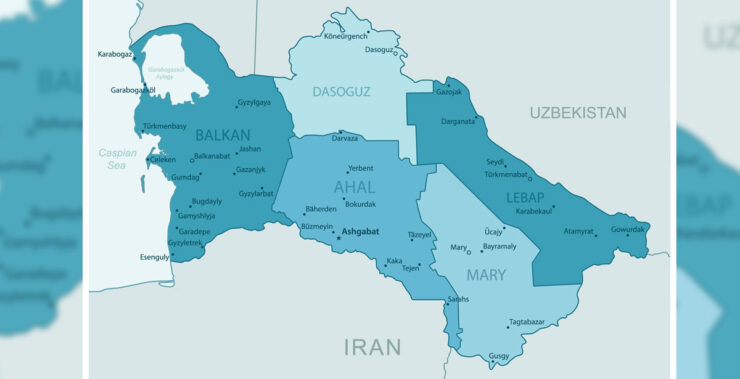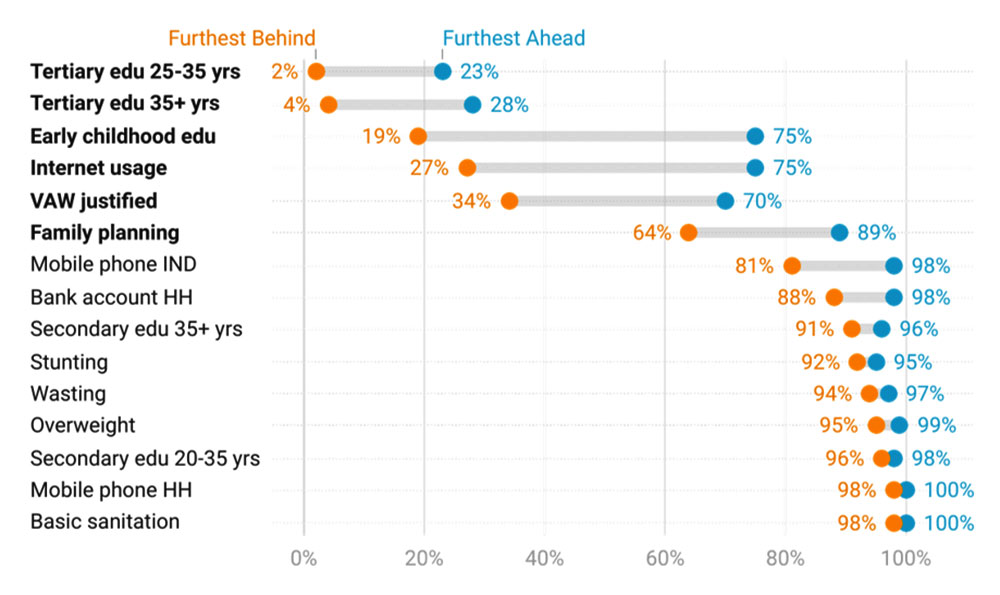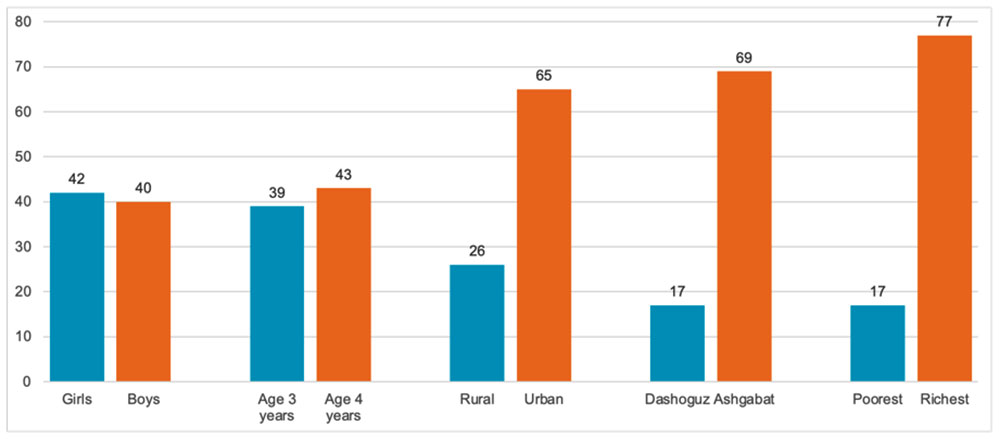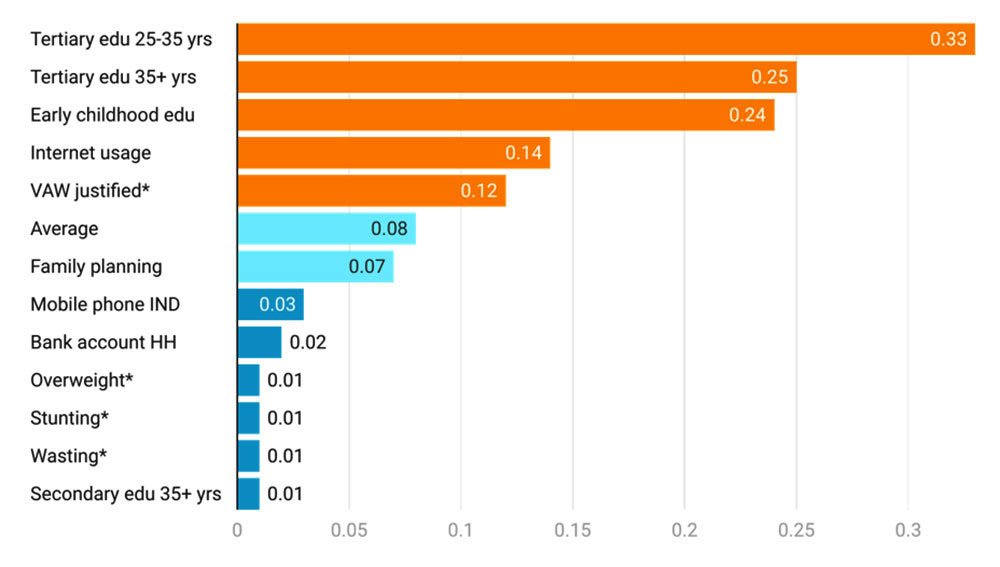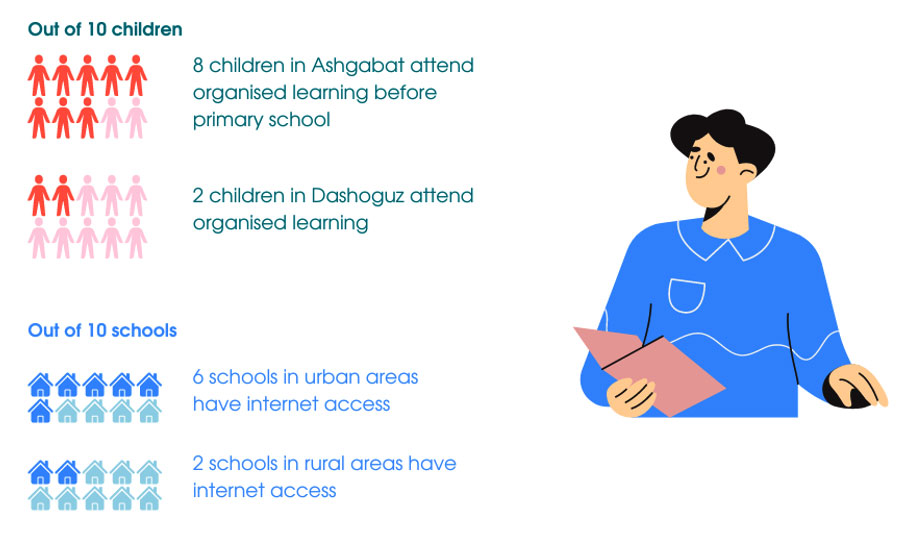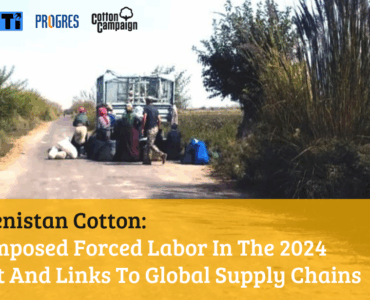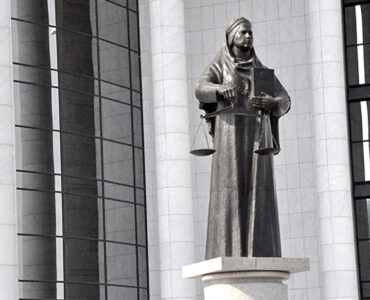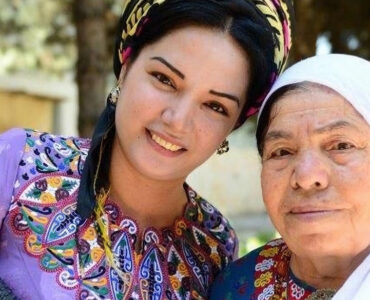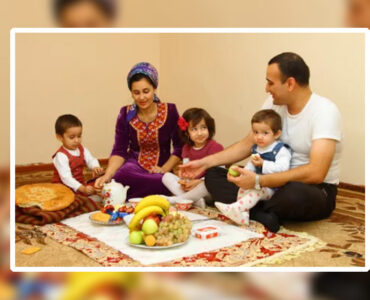How where you live in Turkmenistan determines your access to resources and opportunities.
Summary: Person’s place of birth and residence determine how much development they experience. Ashgabat outperforms all other regions in terms of life expectancy, expected years of schooling and income. Residents in Ashgabat live an additional 4.5 years compared to those in Mary; children in Ashgabat participate in organized learning prior to primary school 5.7 times more than those in Dashoguz and adults receive 1.6 years of extra schooling. Meanwhile, there is no vision, no targeted policies and subsidies that would meet the needs of the rural population and ensure their fundamental rights to basic services. Turkmens in rural areas do not enjoy the same level of human development as their fellow citizens in Ashgabat.
There are differences in the level of human development people in Turkmenistan experience based on their geographical location. While there is no disaggregated data at a level of provinces and rural households, this article uses publicly available statistics to paint a picture of what it means to be born in a particular place. To get a balanced view on human development in Turkmenistan information for this article comes from variety of international and national sources such as Human Development Reports from UNDP, Leaving No One Behind from UNESCAP, the World Bank, Global Data Lab, BTI Transformation Index, Progres.Online, Turkmenistan Multiple Indicator Cluster Survey (MICS) 2019 and Voluntary National Reviews of Turkmenistan (VNR 2019, 2023).
Inequality refers to the unequal distribution not only of income and wealth, but also of opportunities and services. Inequality of opportunity undermines the realization of human rights and human potential and constitutes a barrier for social mobility and progress. Leaving No One Behind (LNOB) country brief for Turkmenistan helps discover how different circumstances interact to create unequal access to basic opportunities and provides insights into which groups are further ahead and further behind in various Sustainable Development Goals (SDGs) indicators.
In Turkmenistan gaps remain between the best-off and the worst-off groups in access to different opportunities, which is illustrated in Figure 1. Bolded indicators on the top have the largest difference between these two groups.
Figure 1. The gaps between the furthest behind and the furthest ahead groups in Turkmenistan across all available indicators, 2019
*Note: standard analysis with 6,195 observations. The orange circle represents the average rate of the furthest behind group, the blue circle represents the average rate of the furthest ahead group, and the gray bar represents the difference between these two groups.
**From the chart VAW stands for violence against women, HH – household, IND – individual.
Source: Leaving No One Behind.
People in Turkmenistan do not have equal access to basic resources. The largest difference (56%) between people who are the furthest behind and furthest ahead is in access to early childhood education. Only 19% of children with 3 or more siblings under 5 years of age in rural areas have completed early childhood education compared to 75% of boys with one or no siblings in urban areas. There is a significant difference between the capital city and the rest of the country. To illustrate, out of 10 children in Ashgabat 8 attend organized learning, one year prior to primary school, while in Dashoguz velayat it is only 2 children (MICS 2019). Higher preschool enrollment rate among children of urban residents and higher income families, result in a greater advantage in accessing higher education, which further facilitates discrepancy between rich urban population and poor rural population.
Figure 2. Attendance at early childhood education programs in Turkmenistan, 2019
Source: Turkmenistan Multiple Indicator Cluster Survey (MICS) 2019.
Furthermore, the Dissimilarity index or D-Index shows how different groups – such as women, poorer households, or rural residents fare in terms of access to a certain opportunity, or how they disproportionately experience a certain barrier. D-Index ranges from 0 to 1, where higher value indicates greater inequality. Figure 3 shows the level of inequality for various indicators in Turkmenistan. The highest level of inequality between groups is in access to tertiary education among 25–35-year-olds (D-Index of 0.33).
Figure 3. The level of inequality (D-Index) among furthest ahead and furthest behind for various indicators in Turkmenistan 2019
Note: For barrier indicators (*) the D-Index is calculated for the absence of the barrier (e.g stunting becomes absence of stunting), to allow for data comparability with opportunity indicators. Indicators such as electricity, mobile phone HH, basic sanitation, skilled birth attendance, basic drinking water and secondary edu 20-35 yrs were excluded from the chart because they equal to ‘zero’.
Source: Leaving No One Behind.
Figure 4 further illustrates access to tertiary education among 25–35-year-old adults in Turkmenistan based on their income, gender and geographical location. Only 1 in 10 people in Turkmenistan have completed tertiary education. Person’s household income, place of residence and gender determine how much schooling they receive. Only 2% of poorer women have completed tertiary education compared to 23% of richer men in urban areas. Closing the gaps in education would help reduce inequalities in financial inclusion and decent work opportunities, while allowing broader development gains through sustained human capital accumulation.
Figure 4. The classification and regression tree in tertiary education (25-35 years of age) in Turkmenistan
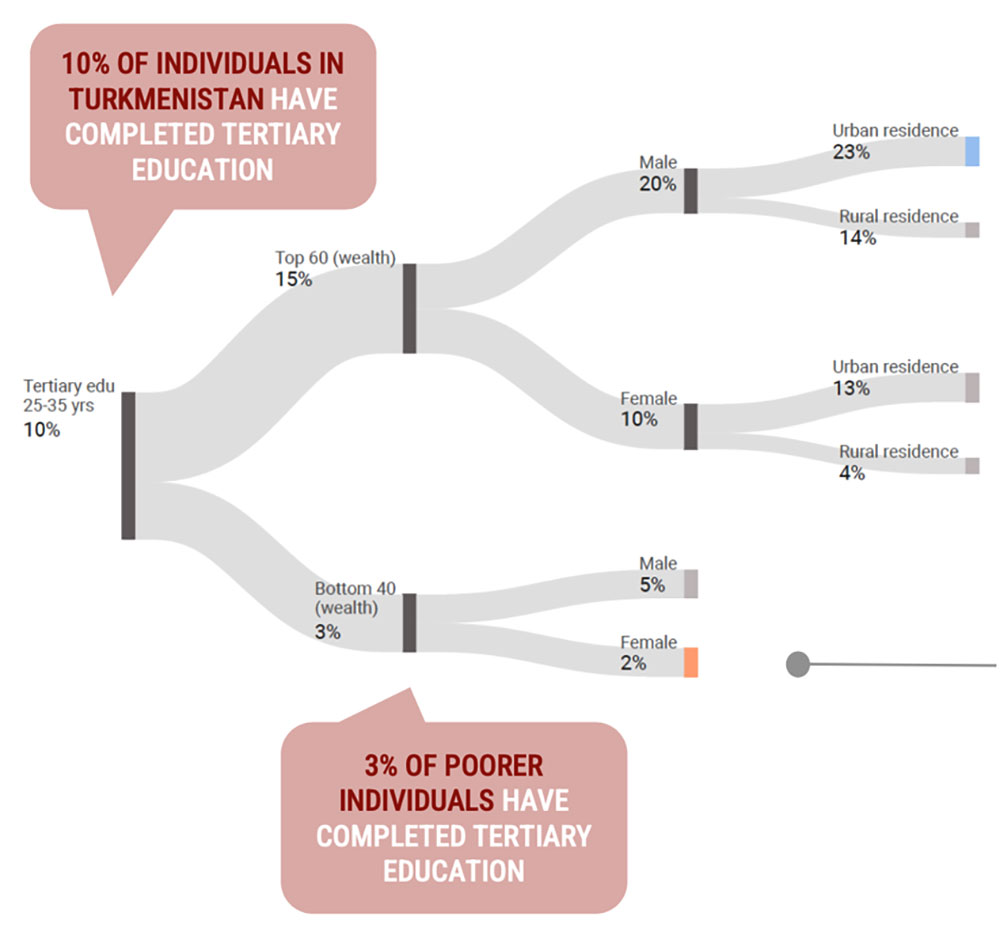
Source: Leaving No One Behind (LNOB).
In Turkmenistan 52.9% of people live in rural areas. Large-scale poverty and unequal opportunities for social and economic participation are widespread in rural areas of the country. Salaries in rural provinces are 33% less than those in the cities, and one out of two inhabitants are considered poor while in the cities, it is one in three inhabitants. Young people living outside the capital have particularly poor prospects for getting an education, owing to the paucity of secondary schools in the provinces. Access to full-time jobs is primarily impacted by a person’s level of education. This means, individuals from poor households and rural areas have limited access to higher education and hence to full-time employment putting them in a vicious cycle of poverty.
Access to communication technology is also affected by one’s place of residence. For example, urban residents have three times more access to the Internet than rural residents. Only 23.3% of schools in rural areas have access to the Internet for educational purposes compared to 64.4% schools in urban areas in 2022. Similarly, infrastructure and materials adapted for students with disabilities was at 0.1% in rural areas compared to 2.5% in urban areas in 2021.
Source: MICS 2019 and VNR 2023.
Someone’s place of birth and residence can also affect the length of their life. For example, a person in Ashgabat lives, on average, 4.5 years longer than a person in Mary. It is worth mentioning that in 2004 and 2005 Turkmenistan’s first president Saparmurat Niyazov fired 15,000 medical workers by closing down all regional hospitals in the country. While president Gurbanguly Berdimuhamedov reversed this decision, it had already made a significant damage to the health of the population. At the same time, most of the reforms were cosmetic and investments were confined to big cities, especially Ashgabat. Meanwhile, the rural hospitals lack sterilized appliances, drugs, and the most basic equipment. The health care system struggles with ineffective management of the newly built medical facilities, high levels of corruption, lack of medical consumables and medicines, acute shortage of specialized doctors and poor standard of health care in the rural areas.
Children in Turkmenistan are born into and grow up to limited possibilities with high risks for their wellbeing, educational attainment and career perspectives. For example, 7.1% of children experience stunting and another 2.4% experience severe stunting, which is impaired growth and development due to poor nutrition, repeated infection, and inadequate psychosocial stimulation. The stunting in rural areas is slightly higher than in urban settlements (7.9% and 5.8%, respectively). In Mary velayat 1 in every 10 children face an increased risk of stunting. As demonstrated through the Human Capital Index, which excludes Turkmenistan due to lack of data, children in Central Asia will be 60% as productive when they grow up as they could be if they enjoyed complete education and full health. That is a loss of human potential which can be prevented through targeted policies from early childhood education and development to tertiary education, employment and holistic healthcare.
Finally, a person’s place of birth not only determines the opportunities they are born into but also opportunities they can access as they grow up. This is done through the use of “propiska” or registration that one receives in their place of birth. It was inherited from the Soviet Union as a way to manage internal migration. Given the poor quality of education and healthcare and lack of jobs in the country’s provinces, many rural residents wish to move to bigger cities in search of better opportunities. However, the registration policy makes it almost impossible for these individuals to legally relocate within their own country and purchase a house, get employment, access education and healthcare services and social benefits in the new location. Moreover, registration became another source of corruption. People who have the money and connections can find ways to change their registration while those from disadvantaged families are unable to change their environment and circumstances. This policy robs citizens of their right to equal opportunities and equal access to basic services.
Household wealth, the place of residence, educational level and gender are behind most of the inequality in access to opportunities in Turkmenistan. Living in rural areas seems to be the most important circumstance shaping a person’s development. People living in the provinces experience a double curse of living in rural areas which lack access to quality education, healthcare and employment, as well as being poor. This puts people in a vicious cycle of poverty because without appropriate education and healthcare they cannot pursue well-paid full-time jobs, without which it is extremely difficult to escape the trap of poverty. There is a lack of appropriate policies targeting the poor and socioeconomically disadvantaged families. According to the World Bank, most of the government subsidies are poorly targeted since they are available to the whole population regardless of their income level. At the same time, these funds are not being used efficiently. Alleviating poverty, however, is more than just providing the means for survival through subsidization. It is also measured in access to opportunity.
Recommendations to the government of Turkmenistan
This research has demonstrated unequal access to resources and opportunities due to a person’s place of birth and residence. To ensure the same level of human development across the population the Turkmen government should implement targeted policies that meet the needs of those left behind. Below are some important steps the government can take:
- Collect accurate and disaggregated data. The government can no longer make policies in the dark. It has to collect detailed data about its population, which is disaggregated based on age, gender, place of residence, level of education, household income among other things to understand who lacks access to basic services, why their access is inhibited and what policies and programs can better meet their needs.
- Ensure even socioeconomic development of the regions. Since Turkmens living in rural areas face unequal access to basic services, the government should pursue an even socioeconomic development where people, both in urban and rural areas have equal access to opportunities. By doing an in-depth needs assessment of the provinces and rural areas, the government should adopt nuanced policies and targeted subsidies while empowering local officials to take independent initiatives based on the needs of their constituents.
- Remove propiska or registration policy – the use of “propiska” penalizes Turkmen citizens for being born in a specific location by hindering their ability to move freely and access essential services and opportunities. The government should allow internal free movement of labor and facilitate internal migrants’ access to medical and social services. Every citizen of Turkmenistan, regardless of where they are born, should benefit from equal opportunities to develop.
- Provide equal access to quality education. Closing the gaps in early childhood and higher education would help reduce inequalities in income and employment, while allowing broader development gains through sustained human capital accumulation. The government should ensure that children and youth from disadvantaged and rural households have unrestricted access to education at all levels by having quotas and reserving spots for them.
- Improve the quality and access to education. The government should focus on increasing access to pre-schools, vocational schools and universities, especially in rural areas, developing and disseminating better quality textbooks, introducing nationwide testing of students’ achievement to monitor their performance, increasing the use of Internet and teaching of ICT skills in the schools and universities, improving teacher training programs and incentivising for both men and women to pursue and remain in teaching careers.
- Improve healthcare system. The shortage of cash in the public health care system has been a chronic problem in Turkmenistan. There is lack of transparency and efficiency in the way healthcare budgeting is managed. The healthcare system in Turkmenistan remains centrally governed. It focuses more on administration rather than management with little decision-making power exercised at healthcare facilities. This has to change. Hospitals and healthcare professionals should be given the autonomy and adequate resources to make independent decisions based on healthcare needs of people they serve.
- Reform the agricultural sector. Given that the majority of the poor people live in rural areas, most of whom are engaged in agriculture, reform of the sector would have a major impact on the livelihoods of many rural families. The state owns 100% of the land, dictates what crops to cultivate, sets the harvest quota and buys these crops at fixed prices. This leaves tenant farmers with limited incentives to productively cultivate the land and with minimal income to provide for their families. Hence, the government of Turkmenistan should allow private ownership of the land and give farmers freedom to grow crops, set prices and sell their harvest using the rules of the free market economy.
This is the fifth article in a series focused on human development and potensial in Turkmenistan. The previous articles looked at Turkmenistan’s performance on the Human Development Index, government spending on human development, gender based inequalities and inequalities in education and health systems.

